Things Worth Experiencing
- Tenement Museum
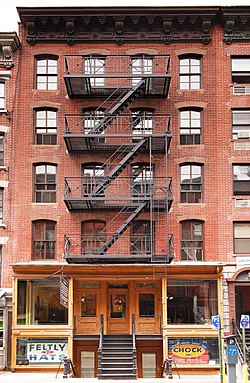
Tenement Museum at 97 Orchard
For a cultural insight, one should visit the Tenement Museum. Through the tour, one can get a true sense of the atmosphere many immigrants experienced as they started their new life in America. With parts of the building being in its original condition, the building is a standing relic and symbol of the immigrant life that meant so much to the Lower East Side. Insightful tour guides even go into detail about specific families that lived in the very rooms you tour. The hardships of immigrant families can be seen through the unsanitary and tight living quarters. After visiting, one can truly appreciate the progression the Lower East Side has made from an immigrant neighborhood into a young, artistic scene.
- Katz’s Delicatessen

Katz’s Deli
Championed for its legendary pastrami, Katz’s Delicatessen is great place to visit when looking for a meal. Established in 1888, the deli is one of the few remaining relics of the old Hebrew Quarter. Pastrami from Katz’s Deli symbolized a taste of home to many immigrant Jews. The deli meant more to immigrants than simply a place to eat; it was a reminder of their unique culture. Today, people from around the world visit Katz’s for the coveted pastrami. The meat takes thirty days to prepare, contributing to its superior nature. Katz’s Deli is a timeless classic that offers insight into the past and, possibly, more importantly, pastrami.
- Other Restaurants

Mission Chinese Food at 171 East Broadway
Katz’s Delicatessen isn’t the only place you can get a great bite to eat and experience history in every bite. There are many restaurants which embody the culture of New York City. Visitors and natives alike can visit restaurants such as the Russ & Daughters Cafe, famous for their bakery. If one’s in the mood for Asian food, Mission Chinese Food and Pig & Khao fuze Southeast Asian flavors to satisfy their customers.
- Museum at Eldridge Street
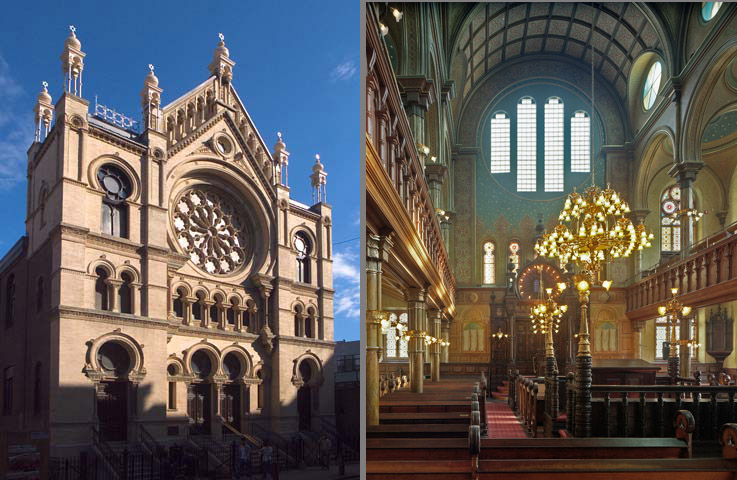
Interior and exterior of Eldridge St Synagogue at 12 Eldridge
The Museum at Eldridge Street is an old Jewish synagogue that was converted into a museum for all to indulge in. Opening its doors in 1887, it was built by the very immigrants who came to America. The space carries sentimental value as it provided an escape to thousands of Jewish immigrants in taxing living conditions. There is even a small congregation that still uses the space for services. The aesthetically pleasing synagogue has high ceilings and unbelievable architectural influences that still amaze visitors today. One does not need to be of the Jewish Faith to appreciate the detail of the structure.
- Food at the Feast of San Gennaro

Cannoli-eating competition at the San Gennaro Feast
Brought over in 1926 by Italian immigrants, the Feast of San Gennaro is an eleven-day annual celebration of both the immigrant and American cultures. This September marks the 89th anniversary of the festival. The festival celebrates the struggles of Italian immigrants making their life in America. But an Italian festival would not be complete without its food. Every year Mulberry street, running from Canal to Houston, is closed to traffic and the food carts, the local restaurants, and the food vendors return home to Little Italy. This is one festival, if you’re lucky enough to be in the city in September, you would not want to miss. For a week attendants are delighted with top quality meatballs, linguini, and even a world-famous cannoli-eating competition. Come for the culture, stay for the food. The Feast of San Gennaro not only recognizes the struggles of Italian immigrants but also celebrates it.
- Must see graffiti: “Temper Tot”

Temper Tot Mural at 114 Mulberry
One of the best examples of what happens when pensive street graffiti meets the comedic flair of pop-culture artists, the “Temper Tot” is a mural that makes you think. Subverting the expected, the piece is part of Ron English’s “Popaganda” series. One of the first things people usually ask is “How the heck did he manage that?” Indeed the wall of a tenement overlooking a parking lot is his canvas. Near the corner of Mulberry and Canal streets, the mural depicts the Hulk complete with the overly muscular body and jeans ripped and a size too small, but with a baby’s head and face. And the most striking thing about the mural is how the boy seems to be in pain. It’s so out of the ordinary but it isn’t. In our own socially accepted competition for vanity, (to be the most muscular, the most beautiful, the most successful), we often neglect our own selves, our own happiness. Temper Tot speaks to the notion that we are something more than our physical bodies, our physique and perhaps with the baby face, the artist is telling us that we are all good and innocent in a way. Temper Tot is a must see mural in the Lower East Side.
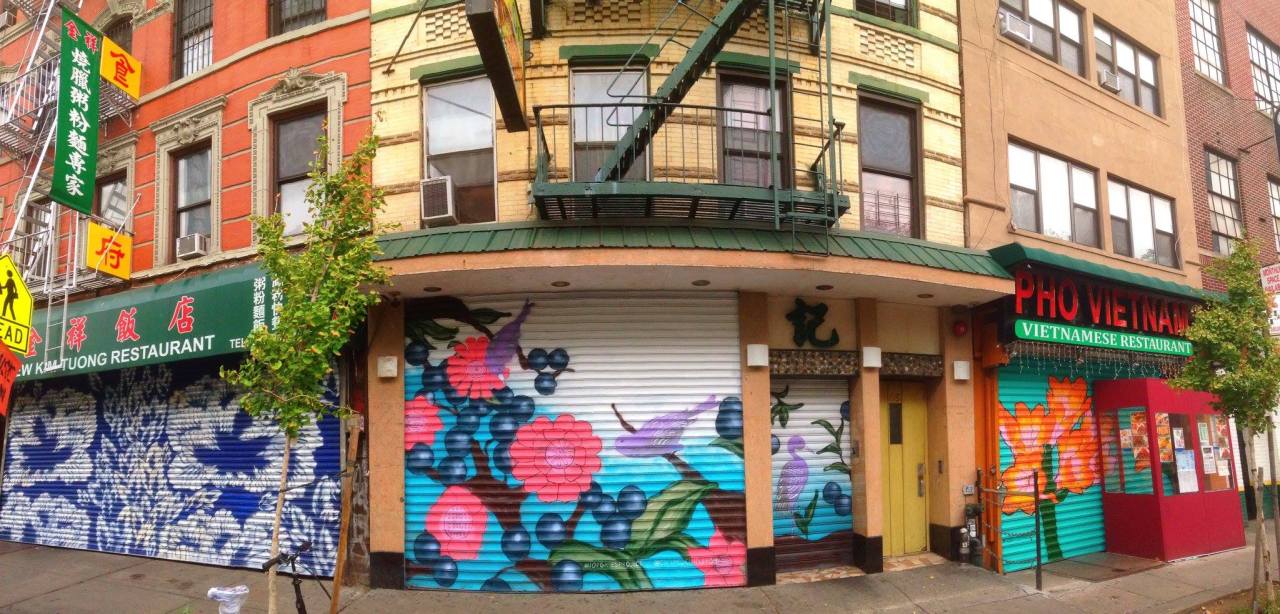
Three beautiful renovated gates at 83-87 Chrystie
- 100 Gates
Around the city, particularly in the early mornings or late at night, you might have seen interesting designs or fantastic murals spray painted on the steel gates of a business. No, there isn’t some vigilante parading around the neighborhood vandalizing property to mete out his own idea of street beauty, like a sort of Batman with a spray can. The 100 Gates project is the brainchild of former pro skater and artist, Billy Rohan, with the Lower East Side Partnership, working to beautify the neighborhood and give it that flair that everyone knew it had but seldom saw. Walk around the neighborhood to see if you can spot them.
- Williamsburg Bridge
The Williamsburg Bridge (Fig 28) [vii] is a suspension bridge which connects the Lower East Side of Manhattan with the Williamsburg neighborhood of Brooklyn. The bridge itself is worth seeing. Many take runs and bicycle rides on the bridge and enjoy the views of Brooklyn and Manhattan. There is also a plaza at the foot of the bridge on the Brooklyn side, called Williamsburg Bridge Plaza or George Washington Plaza, which can be used as a recreational area. Come here with your friends and family to relax while in Brooklyn, and then take a train or lengthy-yet-pleasant walk back to the vibrant Lower East Side.
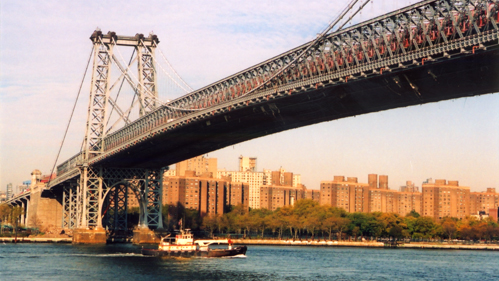
- Angel Orensanz Center
Figure 29: Angel Orensantz Center
The Angel Orensanz Center, (Fig 29)[viii] originally named the Anshe Chesed Synagogue, is the oldest surviving synagogue in New York City. Built in a gothic style, the synagogue had a history of a congregation of German, Dutch, and Polish Jews. The synagogue is magnificently colored, adorned with vibrant patterns and a huge interior. A visitor to the Lower East Side must make a spot in visit to see this piece of New York City’s history.
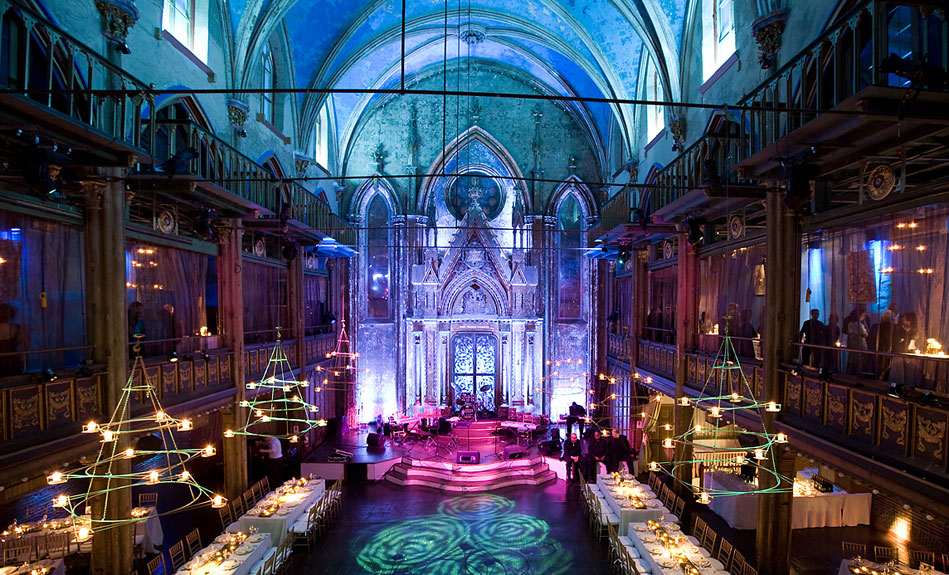
- Seward Park
Figure 30: Seward Park in Spring
After spending a day touring the Lower East Side, you may want to relax somewhere. Seward Park (Fig 30)[ix] is a public park in the Lower East Side where families, couples, and friends can unwind and enjoy the park. Integrated with nature and surrounded by historic buildings and apartments, Seward Park is a perfect place to start a morning or end a day in one of Manhattan’s most historical areas.

